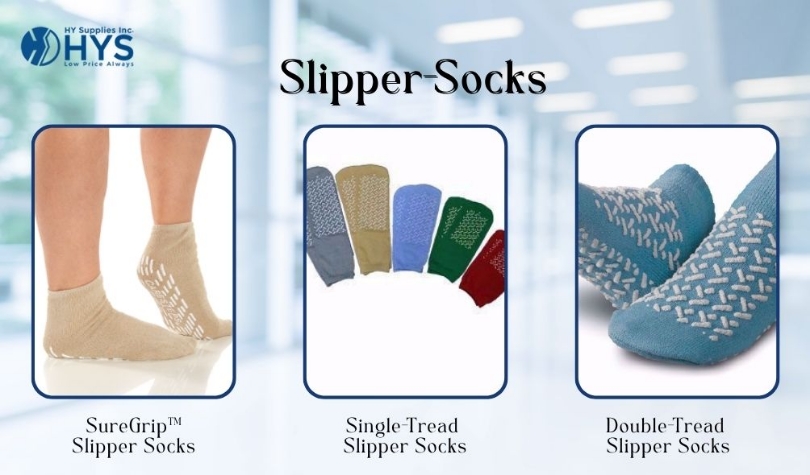Non-Slip Hospital Socks: Benefits, Types, and Importance for Patient Safety

What are slipper socks for hospitals?
The slipper socks, or non-slip gripper socks for hospitals, are footwear designed for use in hospitals and healthcare settings. These anti-slip socks provide patients comfort, warmth, and, most importantly, safety by reducing the risk of slips and falls. It comes with rubberized or textured grips on the soles, making walking easy on smooth, slippery hospital floors.
Types of hospital non-slip socks
Hospital non-slips are available in various types based on the different needs of the patient and the environment in which they are used.
-
Single-Tread Socks:
Single-tread socks have non-slip grips on one side of the sock, typically on the sole. These socks with threads are suitable for patients who remain in bed or require occasional mobility support.
-
Double-Tread Socks:
Double-tread socks are non-slip socks with treads on both sides of the socks. It mostly suits patients who experience the socks rotating or twisting on their feet. The dual grip ensures safety despite the sock’s orientation.
-
Bariatric Socks:
Bariatric socks are designed meticulously for patients with larger feet requiring additional stretch and comfort. Such socks provide the same non-slip features but with a broader fit to accommodate different foot sizes.
-
Pediatric Socks:
Slip-resistant socks for children are in smaller sizes and feature playful designs or appealing bright colors for young patients. It provides the same level of safety and comfort constructed for tiny feet.
How gripper socks for Hospitals help in patient’s comfort
Despite the safety the gripper socks offer, they also elevate the comfort and well-being of the patient.
-
Enhanced Safety:
The rubberized grips on the soles decrease the risk of slipping and falling on smooth hospital floors. This feature is crucial for elderly patients or those with mobility impairments, helping them regain confidence in their movements. -
Warmth and Insulation:
The ambiance of the hospital is often maintained at cooler temperatures for hygiene and comfort. Fall Prevention Socks for hospital floors provide warmth, preventing feet from getting cold, which is especially beneficial for patients’ comfort and recovery from surgery or those with circulation issues. -
Improved hygiene:
Walking barefoot in hospitals is neither practical nor hygienic. Slipper socks act as a barrier between the foot and the floor, reducing exposure to germs and bacteria. -
Soft and Comfortable Fit:
Made from materials like cotton, polyester, or a blend of both, gripper socks are smooth on the skin. Many feature seamless designs to prevent irritation, making them ideal for patients with sensitive skin. -
Mobility Support:
Patients undergoing physical therapy or recovering from injuries can benefit from the added grip, which provides stability during light exercises or when walking short distances.
What are the color options available for healthcare non-slip socks?
Color coding is a common practice in hospitals for identifying patient needs or statuses at a glance. Slipper socks come in various colors, each serving a specific purpose:
- Yellow: Yellow socks often indicate a fall-risk patient, alerting staff to provide extra assistance or supervision.
- Red: Red slipper socks may signify patients with certain medical conditions or allergies, ensuring appropriate care and attention.
- Blue: Blue socks are typically given to standard-risk patients, often those who do not require special mobility assistance.
- Green or Orange: These colored anti-slip socks for hospitals may denote specific hospital departments, wards, or care levels.
- Other Colors: Some hospitals use customized colors or patterns to align with their internal protocols or branding. Pediatric socks often feature fun designs and vibrant hues to comfort young patients.
The availability of multiple colors ensures both functionality and personalization, making it easier for staff to deliver targeted care.
Can slipper socks be washed?
Of course, slipper socks can be washed. It is a practical and cost-effective option for hospitals and patients. These patient safety socks withstand frequent washing and use without compromising their hygiene and quality.
Washing Guidelines
- Machine Washable: Most hospital socks can be machine-washed gently with cold or warm water.
- Avoid harsh detergents: Use mild, hypoallergenic detergents to prevent skin irritation.
- Air dry or tumble dry low: You can preserve the grips by air drying, but some socks can be tumble-dried on low heat.
- Avoid bleach and fabric softeners: These chemicals can degrade the gripper material and reduce the effectiveness of the socks.
Proper maintenance ensures that slipper socks remain practical and comfortable over time.
Conclusion
Hospital non-slipper socks for nursing homes and hospitals are essential to patient care, offering safety, comfort, and hygiene. They cater to diverse patient needs with various types available, such as single-tread, double-tread, and compression variants. Their gripper soles provide stability, while their soft materials ensure warmth and comfort.
Color-coded options further enhance functionality by aiding healthcare providers in identifying patient statuses. Additionally, their washable nature makes them a sustainable choice for hospitals and individual users. In summary, bulk hospital slipper socks are a simple yet highly effective solution for promoting patient safety and well-being in healthcare settings.
Click Here to shop the Non-Slip Hospital Sock.







